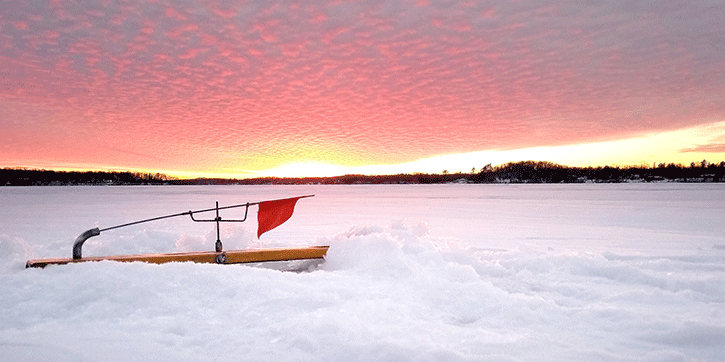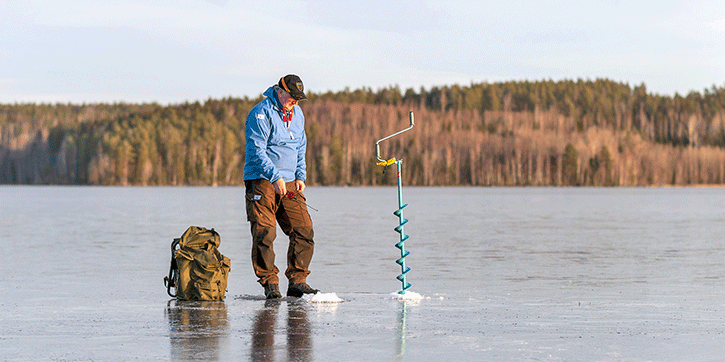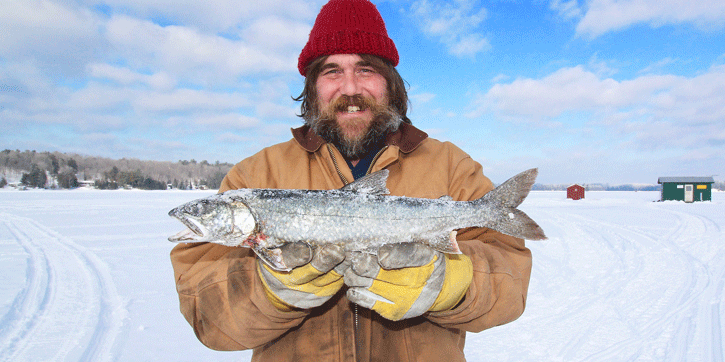Each winter, the state’s largest waterbodies are transformed into makeshift villages with wooden, metal, and even nylon shelters topping thick layers of ice. But these transient winter villages are no migrant Inuit population—but rather a community of passionate ice fishers huddled in their warming huts, all hoping to reel in the season’s biggest catch.
So if you’re looking for a new hobby this winter, look no further. We’ll fill you in on all the details you need to know to make your next ice fishing adventure a success here in New Hampshire.
Mark Beauchesne, local fishing expert and guide offered some insight into the sport. So let’s start with the basics.

WHEN IS ICE FISHING SEASON IN NEW HAMPSHIRE?
Typically, ice fishing season starts upon the declaration of “ice in” and ends upon “ice out” here in the Granite State. According to the
New Hampshire Department of Fish and Game (NHFG), these declarations usually fall between late December and mid-April, but can vary depending on weather and safety conditions out on the ice.
CAUTION: Be sure to check the ice depth before stepping foot onto what seems like solid ice. Looks can be deceiving!
You’ll want to look for solid blue/black ice that is at least 4-6 inches deep to support a few well-dispersed people. Ice 8-10 inches deep can support OHRV activity, but it’s important to check the ice in multiple locations starting from the shore to ensure the ice is an appropriate depth to support these activities. For more ice safety tips, familiarize yourself with the information found in NHFG’s
Safety on the Ice pamphlet.
WHAT SORT OF GEAR IS NEEDED TO ICE FISH?
CLOTHING
Layers, layers, layers. You’re going to want to have multiple levels of protection sheltering you from the cold. And it may be wise to pack extra clothing to keep safe in your car, because let’s face it, something is bound to get wet and if you don’t have a backup, things can turn south pretty quickly in frigid conditions. Here are some expert recommendations to keep you nice and toasty out on the ice:
- Insulated Waterproof Boots
- Warm Socks (wool is best, and try to avoid cotton as it holds on to moisture and drains heat)
- Insulated Under Layer/Thermal Shirts and Trousers
- Additional Insulating Layer (such as a fleece coat or cozy wool sweater and pants)
- Wind and Waterproof Outer Layer (think your best winter ski or sledding coat paired with snowpants)
- Gloves and/or Mittens (be sure to pack extras as your hands are likely to get wet!)
- Winter Hat
- Scarf
 FISHING EQUIPMENT
FISHING EQUIPMENT
As an age-old tradition, ice fishing has roots planted deeply in the past. And while ice anglers of yesteryear may have used primitive tools to drill their holes and capture their game, the tools and tricks of the trade have modernized to match the technology today. Consider this packing list of essentials to ensure you have a successful trip out on the ice:
- Sled (to transport your tools, equipment, extra blankets, seats, and snacks)
- Ice Chisel and/or Ice Auger
- An ice chisel can be used to re-open previously drilled holes or to test the ice depth in various locations. An ice auger is a more sophisticated tool used to efficiently drill holes through thick ice. Either tool will work to open icy surfaces, but it should be noted that both hand and power ice augers often require less man-power.
- Ice Scoop (basically a slotted spoon used to skim out ice chips and slush floating in your fishing hole)
- Conventional Fishing Rod or Reel
- Fishing Bait (experts recommend live bait to reel in the best catches!)
WHAT DO I NEED TO KNOW ABOUT ICE FISHING IN NH?
FISHING LICENSE
A fishing license is required by the state of New Hampshire for anglers aged 16 and up. Licenses can be purchased online, by mail, or in person at one of NHFG’s many licensing agents. Check online for more detailed instructions on obtaining required licensing.
Insider’s tip: There are 2 Free Fishing Days per year where residents and non-residents are invited to fish without a license—the first Saturday in June and the third Saturday in January!
ICE FISHING TRAP RESTRICTIONS
On most New Hampshire waters, fishers can set up to 6 traps (or lines) per person. But there are exceptions to this rule for different bodies of water where restrictions are tighter. NHFG has resources online outlining trap limits by location.
SO WHERE CAN I CAST A LINE? AND WHAT KIND OF FISH ARE BITING IN NEW HAMPSHIRE’S WATERS?
Beauchesne pointed to Lake Winnipesaukee as a popular ice fishing destination. As the largest lake in the state, this comes as no surprise! Other popular locales include Lake Sunapee, Newfound Lake in Bristol, and Crystal Lake in Gilmanton. For more information on where to fish in the Granite State, check out NHFG’s regional fishing guides.

And as for the fish? “Rainbow Trout, Lake Trout, and White Perch are prized by anglers,” Beauchesne says. Other common catches on the lakes include smallmouth bass, small crappies, pumpkinseeds, burbot, and plenty more! Check out this video for additional tips on which of NH’s frozen lakes to head to when trying out this sport!
ASK THE EXPERTS
If you’re still a little unsure and would prefer to leave the details to an expert who knows the ins and outs of the sport, there are plenty of local guides ready to show you the ropes. The New Hampshire Guide Association offers a list of certified fishing guides who know just where the fish are biting and can lead you on your next ice fishing adventure!